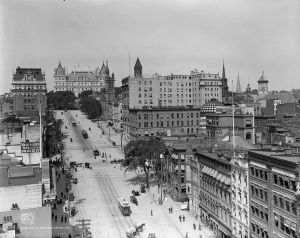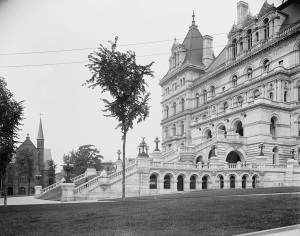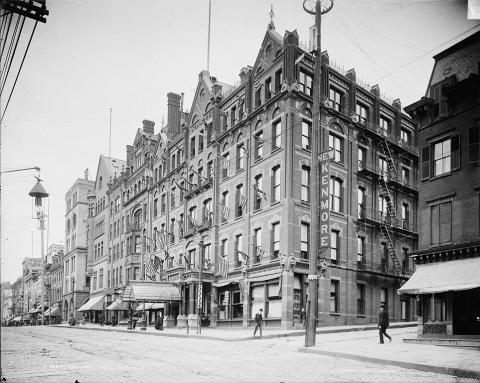This week we have some essential tips for those researching ancestors from Albany County, New York. Read on for a brief county history, useful online resources, some recommended repositories to visit in person and a few little-known facts about Albany County.
History
In 1609, while navigating the river that would later bear his name, Henry Hudson came close to present-day Albany.
In 1624, the Dutch West India Company established Fort Orange - the first permanent settlement in the area and the future location of Albany - as a trading post for Dutch and French fur traders. Only a few years later, European settlement would begin in earnest with the establishment of the Dutch colony of Rensselaerswijck, although the English took political control of the colony in 1664.
Albany County was established in 1683 as one of the original twelve counties of New York and was once the colony’s largest county, in part because its boundaries were ambiguously defined.
Accordingly, Albany County has many daughter counties:
- Cumberland (1766) (currently in Vermont)
- Gloucester (1770) (currently in Vermont)
- Montgomery (1772) (as Tryon)
- Washington (1772) (as Charlotte)
- Columbia (1786)
- Rensselaer (1791)
- Saratoga (1791)
- Schoharie (1795)
- Greene (1800)
- Schenectady (1809)
A large portion of the present Albany County and neighboring Rensselaer County once belonged to the Van Rensselaers, a family of wealthy Dutch landholders.

Albany County served as a strategic area of military assembly and organization during colonial military conflicts, which brought a fair amount of economic and commercial activity to the region.
Since its inception, the city of Albany has served as an international port; this role has been enhanced by centuries of improvements in transportation technology and the construction of such infrastructural linchpins as turnpikes, canals, railroads, and highways. The rest of the county has benefitted from the city’s place in international commerce, and agriculture, extraction, and manufacturing have developed accordingly.
Migration and immigration to Albany County mostly originated from Northwest Europe and New England up until the mid-19th century, after which significant numbers of Eastern and Southern Europeans arrived in the area. Albany County has also been the home of a significant Black population since the 17th century, although it has increased substantially over the past century.
Archives to visit in person
Albany County Clerk
Records include:
- Court records 1793-present
- Adoptions 1886-1971
- Convictions 1896-present
- Deeds and mortgages 1630-present
- Divorces 1890-present
- Federal liens 1966-present
- Index to incompetents 1963-present
- Judgments 1877-present
- Military discharges 1917-present
- Patents 1784-present
- Selected wills 1691-1833, 1895-1976
Albany County Hall of Records
Holds records of both the city and county of Albany, including:
- Census records 1855-1925
- Court records 1652-1961
- Surrogate’s court records 1800-1840
- Declarations of intention and naturalization 1827-1991
- Death records 1880-1947
- Marriage records for City of Albany 1870-1954
- Church records 1756-1997
- Cemetery records 1878-1977
- Deeds 1654-1894
- Mortgages 1752-1980
- Index to public records property transactions 1630-1940
- Index to wills and letters of administration 1780-1895
- Civil War allotment and correspondence 1861-1899
- Slave manumission register 1800-1829
- Albany city directories 1830-1990
- Atlases 1860-1941
You can find an exhaustive index to their historical records here.
Online resources
The Albany County Hall of Records has a very useful website, which includes some really helpful finding aids on subjects including building research in Albany County, a survey of Constitutional Era (1783-1815) records for Albany County, and a guide to court records.
It also has a searchable index to naturalization records between 1821 and 1991 for Albany County.
The website Connors Genealogy provides transcriptions of Albany County naturalizations between 1836 and 1864 for many Irish-born residents and an online surname registry.

Abstracts from Cemetery at South Bethlehem, Albany County, NY (1929) are part of the New York State Cemetery Abstracts collection in the NYG&B eLibrary
The NYG&B Record vol. 139, no. 1 (2008), also available in the eLibrary, has a Tax List of the City and County of Albany from 1708/9
The NYG&B Record vol. 58, no.2 (1927) has an article on Gravestone Records from the Nicoll-Sill Burying Ground, Albany County, NY.
Transcriptions of vital records from the following churches are available in the New York State Religious Records 1716-1914 in the NYG&B eLibrary:
- First Lutheran Church of Albany
- First Presbyterian Church of Albany
- Reformed Dutch Church of Beaver Dam
- Paul’s Evangelical Lutheran Church of Berne
Finally, the New York Public Library Digital Collections include the New Topographical Atlas of the Counties of Albany and Schenectady, New York: From Actual Surveys (1866) and
Did you know?
Albany is the longest continuously chartered city in the United States.
Albany was known colloquially as Sturgeonville in the mid-1800’s – the large fish, which once thrived in the Hudson river, became known as “Albany Beef” throughout the state.
Learn more about Albany County research
There are dozens of more resources and repositories that are essential for the serious Albany County researcher.
Make sure to check out our Guide to Albany County, New York for genealogists and family historians, which contains useful information on the changing borders of municipalities, state, county and local repositories, and many print and online resources.
An entire chapter of our New York Family History Research Guide and Gazetteer also has a chapter dedicated to Albany County, in addition to more essential information of use to New York State researchers.
